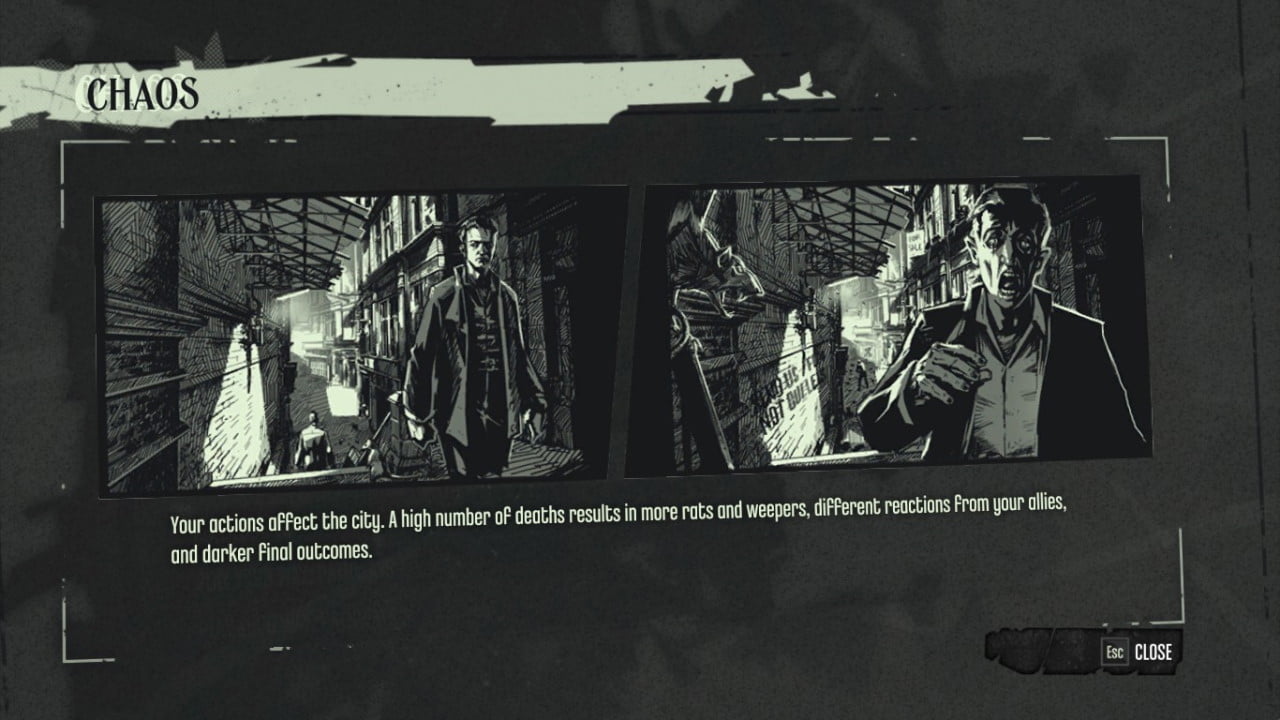An affliction is spreading in Dunwall, an affliction of accelerating industrialization made manifest as disease.
Bodies pile up on the streets and rats come to devour them all. This rodent is immune to the disease and is a carrier of it. Rats spread the disease that afflicts bodies and devour afflicted cadavers that slow the spreading. The disease would cease to be a disease once there are no subjects left to it, but unbeknownst to and because of rats, it persists to contact humans. The rat is a conduit for this force made manifest as disease marching towards levelling destruction.
The rat symbolizes nature as a force of order in contrast with human civilization’s destructive disorder. But forces intervene with the aforementioned force from the Void. It’s a place of “end of all things; and the beginning,” where “all of time is meaningless.” The so-called Outsider reigns here, a godlike figure who exists outside of our spatiotemporal reality and in relation to it. The Outsider is worshipped and feared, his mark and tokens emitting power to influence the order and disorder of things.
There are several dualities at play here, keenly likened to the paradoxical nature of sacrificial violence by Hazel Monforton at PC Gamer and to postmodern ambiguity by Andreas Inderwildi at Eurogamer. These dualities are persistent because the powers at play here are located in the paradoxical plane of time where the past is yet to define the future and this yet defining state influences the present, as observed by Gareth Damian Martin of how “we find implications of a city” in writing about Dishonored’s architecture for Kill Screen. In this piece, he describes Dunwall as a city that’s “inaccessible, but ever present,” like “that feeling of exploring a real city, the knowledge that much of it is out of your reach, more often imagined than visited.” This imagination dwells in the past and points towards the future at once.
Depictions of time weave and intertwine the fabric of Dishonored and forces shaping it. Consider the skill Bend Time. It’s described as a power that slows the world around the player at a push of a button, while “time completely stops” when a stronger form of this power is activated, rendering “enemies and security systems […] unaware” of the player’s presence. This force alters perception, not time, since time is a construct that exists before and after an experience. During perception, we relate parts of it to past experiences that point towards the future. When movement is slowed down, we perceive what there is in that specific space at an altered speed and the alteration itself.

This alteration is explored in relation to experiences that happened in the past. The past itself doesn’t come up during perception, nor does time that contains it. This altered state allows us to act in a slower fashion that we may think of as an experience that gave us more time to act. This thought connecting the alteration to time comes after perception. While perceiving it, we think of the difference in relation to past experiences and the difference it will make relating to the future.
Time is difference. But it’s a different difference from an alteration noticed during perception. We notice difference (movement) which then we relate to a different difference (time) to explain it. Bend Time offers powers for a “limited time,” referring to an amount located in linear space. It connects this interpretation of time (difference) with a force players exert on others (difference) that also affects them (difference) to end up saying that it stretches or stops linearity (difference) while being located in linearity as it happens in time (difference). These five differences are different from each other, but by relating them to the notion of time, they are folded into one another and point towards something different.
When the power Bend Time is activated, characters are slowed down in proportion to ours. We perceive difference in their movement and in the player character’s compared to the past. A difference emerges in relation to different difference. Movement is transformed to this difference that reduces movement of theirs and our own to a singular movement that allows comparability according to this difference. Bend Time grants power to see characters in terms of speed, through which our character exceeds.
The power Blink does something similar. It’s described as a “fast and stealthy forward dash through the world.” In the blink of an eye, we transport ourselves from one place to another to which our surroundings drastically change (difference) while another character may notice our disappearance (difference.) We may be inclined to say how this drastic change in space took place from one moment to another – alluding to time after the fact – while reducing differences to a single difference. Once we get used to what Blink does to time and space, this difference ceases to be drastic and sudden. Would we still be inclined to characterise it as such and construct time in such a manner?
Unlikely, but we’d still be concerned with difference. Comparisons to other characters would be drawn reducing differences. Their past experience differs from ours to which perception relates, reducing difference between them and us. This reduction also occurs in relation to time because when we perceive things based on past experiences we also imagine a future and futures, reducing differences each time we imagine one.

Imagining a future in Dishonored is influenced by an all-consuming disease spreading over time. Scattered notes left behind allude to feverish events happened in the past, culminating to an illness affecting the present, while mission screens evaluate and quantify player action, describing how much their actions contribute towards a chaotic future.
This disease manifests as difference from difference to difference. It’s at once literal and symbolic for power, between nature and culture, cause and effect, that shapes individual and collective action and the disease itself. Rats further complicate and simplify this discursive motif. When they assemble into groups, an insatiable hunger compels them to devour flesh and bone in a matter of seconds. This frames their individual wondering as harmless and idle, whereas their collective assemblage represents a power of labour as deadly force that shrinks linear passage of time. This collective force accelerates decay. Meanwhile, the player character is capable of shrinking time by themselves. Through the decaying lens of disease, the power of Shadow Kill turns bodies into ash, hastening the effects of time to decompose a body almost instantaneously. With the power Devouring Swarm, players can summon a band of ferocious rats with a motion that clenches the air, as if signalling a desire to get a hold of time towards death.
Food and drinks consumed by the player character are swallowed to regain energy in an instant. This energy represents a universal life force that violence lowers and nourishment increases without difference. Good health and malady are intertwined through this universal force that points towards a singular condition. Books, edibles and trinkets shine like treasure to a similar universal effect. Texts allude to past events while trinkets and food point towards a future, as edibles are transformed into life force, valuables into currency. The future in this sense is framed as an effect of acquisition that leads to gain and improvement waiting to be spent towards the ultimate, levelling condition of demise.
Dishonored interprets time as an ordering/disordering force that’s malleable and slips through our grasp, like Dunwall’s universal energy harvested from whales. These majestic animals are elevated from unknown depths for slaughter to fuel the machine of industrialization only to dissipate as smoke in air. Time transforms and subjugates life to power that accelerates and decelerates to leave behind carcasses and excess to imagine external forces of gods and disease that sow chaos and rot as distraction from the rot and chaos abstracting time creates.
Enjoyed this long read? You should support Thumbsticks on Patreon or buy us a coffee to enable more of it.






